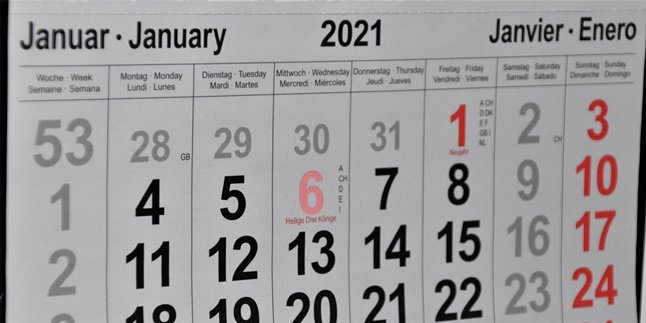Kapanlagi.com - Figure of speech is a very common language style. This is because it is very easy to find examples of figures of speech in literary works that writers often use to make their writing more lively, interesting, and able to influence readers.
Understanding the meaning of figures of speech is certainly very important. Because figures of speech have become a form of language that is quite common. Although often found in literary works, it is not uncommon for people to use figures of speech for everyday conversations.
Because there are various types of figures of speech that can be used to emphasize something, criticize, or compare. That is why below is a discussion of the meaning of figures of speech that you need to understand.
Curious about the meaning of figures of speech? Let's check directly below about the meaning of figures of speech that has been summarized by kapanlagi.com from various sources.
1. The Meaning of Figures of Speech in KBBI

(credit: unsplash.com)
There are many forms of language that are already very well known. One of them is figures of speech which are usually used in literary works. You may have come across figures of speech in a poem, novel, or short story but not realize that it is one example of a figure of speech.
That is why it is important to know the meaning of figures of speech that are included in Indonesian language forms. If referring to the Great Indonesian Dictionary (KBBI), the meaning of figures of speech is a way of describing something by likening it to something else. The meaning of figures of speech can also be called a metaphor.
Yes, basically the meaning of figures of speech is a language style that uses figurative language. So a sentence using figures of speech will be shorter, beautiful, and attract the reader's attention. The languages used in these figures of speech are figurative language or similes using human senses. That's why the sentence will be more lively and more interesting. That is an explanation of the meaning of figures of speech.
2. Meaning of Figures of Speech According to Experts

(credit: unsplash.com)
In the previous discussion, we talked about the meaning of figures of speech according to the dictionary, but there are also several meanings of figures of speech according to the opinions of several experts. As additional information, here are the meanings of figures of speech according to experts that you need to know. Curious about the meaning of figures of speech according to experts? Let's check it out below about the meaning of figures of speech KLovers.
1. Meaning of figures of speech according to Aminuddin: The meaning of figures of speech according to Aminuddin is the language style used by writers when explaining their ideas that are in line with the intended purpose and special effects that will be created.
2. Meaning of figures of speech according to Aina Prihatini: The meaning of figures of speech according to her opinion is a figurative language that can make the writing come alive and have effects that create certain connotations.
3. Meaning of figures of speech according to Prof. Dr. H. G. Tarigan: The meaning of figures of speech is a way of expressing ideas through language style in a unique way by showing the writer's personality and character.
4. Meaning of figures of speech according to Harimurti Kridalaksana: The meaning of figures of speech is the use of language richness by someone in speaking or writing. It is also explained that the meaning of figures of speech is the use of certain styles to obtain certain effects. In addition, figures of speech are also defined as the overall characteristics of the language of a group of literary writers.
Those are some explanations about the meaning of figures of speech according to experts. So, it can be an additional information in understanding the meaning of figures of speech.
3. Types of Figures of Speech

(credit: unsplash.com)
It is not only important to know the meaning of figures of speech, because figures of speech are divided into several types. These types of figures of speech are adjusted to their purpose and usefulness. The explanation of some types of figures of speech can be found below.
1. Figures of Contrast
The first type is figures of contrast. As the name suggests, the meaning of figures of contrast is figures of speech that are used to state something that is contradictory or opposite. In other words, this figure of speech contrasts two opposing things. Then, figures of contrast are grouped into several types, namely paradox, antithesis, and anachronism.
The use of figures of contrast can compare something with time, situation, or certain meanings.
2. Figures of Comparison
The meaning of figures of comparison is a figure of speech that is used by comparing one object with another object. Because of this comparison, figures of speech can also exaggerate, equate, or replace a word with a more subtle one. Among several figures of speech in figures of comparison are hyperbole, euphemism, metonymy, simile, and allegory.
3. Figures of Emphasis
The meaning of figures of emphasis is a figure of speech that is used to state an emphasis. The goal is to convince and influence the reader. Among several parts of figures of emphasis are repetition, pleonasm, rhetoric, climax, anticlimax, parallelism, tautology.
4. The use of contrasting language styles can compare something with time, situation, or certain meanings.
2. Comparison Figures of Speech
The meaning of comparison figures of speech is a language style used by comparing one object with another. Because of this comparison, language styles can exaggerate, equalize or replace a word with a more subtle one. Among several figures of speech in comparison figures of speech are hyperbole, euphemism, metonymy, simile, and allegory.
3. Affirmation Figures of Speech
The meaning of affirmation figures of speech is a language style used to express an affirmation. The aim is to convince and influence readers. Among several parts of affirmation figures of speech are repetition, pleonasm, rhetoric, climax, anticlimax, parallelism, and tautology.
4. Satire Figures of Speech
The meaning of satire figures of speech is a style of language that contains meaning about satire towards something. Its purpose is to satirize someone or criticize a certain condition. In satire figures of speech, there are several types, namely irony, cynicism, sarcasm, and satire.
5. Linking Figures of Speech
The meaning of linking figures of speech is a style of language that contains figurative expressions. In which, in this linking figures of speech, the words used have interconnected meanings. Among the types of linking figures of speech are metonymy and synecdoche.
4. Examples of Figures of Speech in Sentences

(credit: unsplash.com)
Recognizing the types of figures of speech without knowing their examples is certainly incomplete. That's why here are some examples of figures of speech in sentences that can help you understand the meaning of figures of speech.
Examples of comparison figures of speech:
1. Toni's heart is torn apart to see his beloved pet lying stiff.
2. His tears flowed heavily as he watched his brother leave.
3. Budi became Pak Amir's right-hand man.
4. The price of oil has skyrocketed.
Examples of contrast figures of speech:
1. Don't hesitate to visit my humble hut.
2. Even in a crowd, the heart feels lonely.
Examples of irony figures of speech:
1. I feel like throwing up listening to your nonsense.
2. Your wardrobe is so neat that it smells like this.
3. Don't become a useless member of society whose life is meaningless.
Figures of speech for emphasis:
1. His life's path is very dark.
2. That girl who stole my heart, made me fall in love, and left me stunned.
Those are some explanations about the meaning of figures of speech that you need to know. So that it can help you understand the meaning and types of figures of speech.
(kpl/gen/nlw)
Disclaimer: This translation from Bahasa Indonesia to English has been generated by Artificial Intelligence.
















